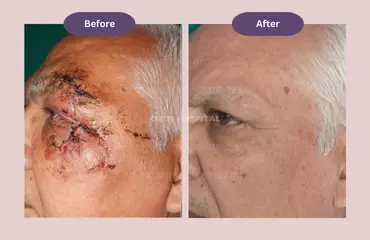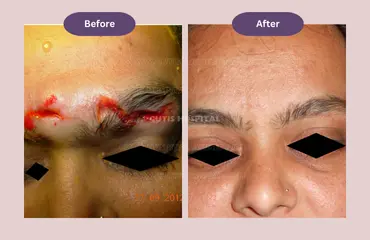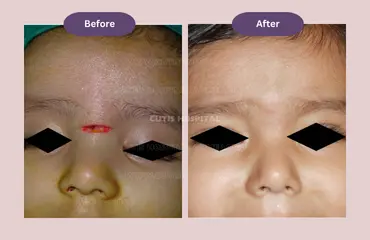Facial laceration is perhaps the most commonly sustained facial injury in each age group.
Toddlers and young children usually sustain facial lacerations due to domestic falls. School
Children and adolescents usually sustain this injury while playing outdoors. While
adults sustain facial lacerations due to vehicular accidents. Due to compromised stability and
mobility of their body, elderly people frequently fall and have facial lacerations. Whatever
may be the age of the patient and causative factor for facial lacerations, early repair (within
24 hours of injury) by a plastic surgeon is the best thing to do. A plastic surgeon has a vast
knowledge of anatomy, is trained to operate with patience, and possesses the ability to use
magnification, and has excellent surgical skills. Thus, all patients with facial lacerations should
consult a plastic surgeon at the earliest.
Laceration (anywhere in the body) is a soft tissue injury with a cut in the skin extending to
varying depths and caused by one or more of the multiple causes. Whenever any blunt or
sharp injury happens over the face, it leads to soft tissue injury of variable severity with the cut of
the skin and deeper tissues, called facial laceration.
As such, all injuries are different from each other. However, certain injury patterns are seen
repeatedly due to similarities in their causation. Based on their pattern of injury, facial
Lacerations can be broadly categorized as:
Simple Lacerations:
These are simple cuts, extending up to the layer below the skin and usually, few centimeters
in length. They can be caused by blunt injury over bony prominences or by sharp injury
anywhere on the face.
Avulsion lacerations:
This is a typical injury observed in vehicular accidents or rarely as a conveyor belt injury;
wherein the skin is forcefully moved over the deeper layers. This is an abnormal movement
with force that results in the rupture of skin (laceration) in a haphazard fashion.
Complex Lacerations:
High-velocity injuries or injuries directly over the bony prominence can lead to rupture of
skin and soft tissues (laceration) with injury to underlying bone (fracture). Thus, the
lacerations directly overlying the fractures are called complex lacerations.
The causes of facial lacerations are different for all age groups of patients. To enumerate few
causes of facial lacerations: domestic falls, sports accidents, assault injuries, vehicular
accidents and factory accidents.
Face has abundant blood supply in our body. As a result, whenever there is any injury over
face, be it an abrasion, laceration or complex injury, bleeding is the first symptom.
Sometimes, bleeding from facial lacerations can be critical, especially when the laceration is
associated with multiple fractures. In such situation, control of bleeding becomes the top
priority. Apart from bleeding, pain is another common symptom. Depending upon the depth
of the injury, deeper structures like muscles, nerves, bones or joints can be injured and patient
might have symptoms pertaining to the injured structure.
Cutis Hospital provides the best treatment in Ahmedabad for facial lacerations. At Cutis
Hospital, qualified and experienced plastic surgeon is available 24 X 7 for the treatment of
facial lacerations.
Our expert plastic surgeon at Cutis Hospital examines and assesses the wound before making
a final decision. After reviewing the history of the injury, a thorough examination of the patient and
his/her wound, and necessary investigations (when indicated), the method of repair is decided
by our expert plastic surgeon. Repair is done under local anesthesia if the laceration is simple
and the patient is an adolescent or adult. Lacerations in children and complex injuries in any age
group require general anesthesia for repair. Associate fractures might require fixation by
mini plates and screws.




Yes, If not sutured properly or left without suturing, facial laceration can lead to ugly scarring. However, the same facial laceration sutured by a plastic surgeon within 24 hours of injury, can result in no scar or a very minimal scar.
Any forceful blunt injury or sharp injury over the face can cause a laceration.
The unsightly scar is the most common complication of poorly treated or untreated facial lacerations. However, deeper and more complex lacerations can produce facial nerve palsy, muscle injury with an imbalanced face, jaw fracture with disturbed tooth arrangements (malocclusion), narrowing of the nostril (stenosis), narrowing of the mouth (microstomia), loss of part of the eyebrow, mustache or beard hairs (alopecia), inability to properly close (lagophthalmos) or open (ptosis) the eye, asymmetry between two sides, and many other unforeseen complications.
Yes. Cutis Hospital is one of best hospitals to receive treatment for facial lacerations.
Yes. There are multiple types of treatment that can help reduce the scar. To enumerate them: silicone gel sheet, pressure therapy, cream program, fractional carbon dioxide laser, intralesional injection of triamcinolone, and 5 fluorouracil.
Cutis Hospital is conveniently located in Ghatlodia, Ahmedabad, making it easily accessible via multiple modes of transportation. Below are the various ways you can reach our facility:
Sardar Vallabhbhai Patel International Airport: Located approximately 12.7 km from Cutis Hospital, offering convenient access for patients traveling from outside the city.
Chandlodiya Railway Station: Approximately 2.4 km from Cutis Hospital.
Ahmedabad Railway Station: Around 11 km from our center.
GSRTC:
Ahmedabad Central Bus Station (GSRTC): About 10.3 km from the hospital.
AMTS:
Bhuyangdev Cross Road Bus Stop: Just 500 meters from Cutis Hospital.
BRTS:
Bhuyangdev BRTS Bus Stop: Only 170 meters from our center.
We provide effective surgical and non-surgical treatments for all parts of the body. At Cutis Hospital, our cosmetic and plastic surgery team is committed to giving patients safe and high-quality care.